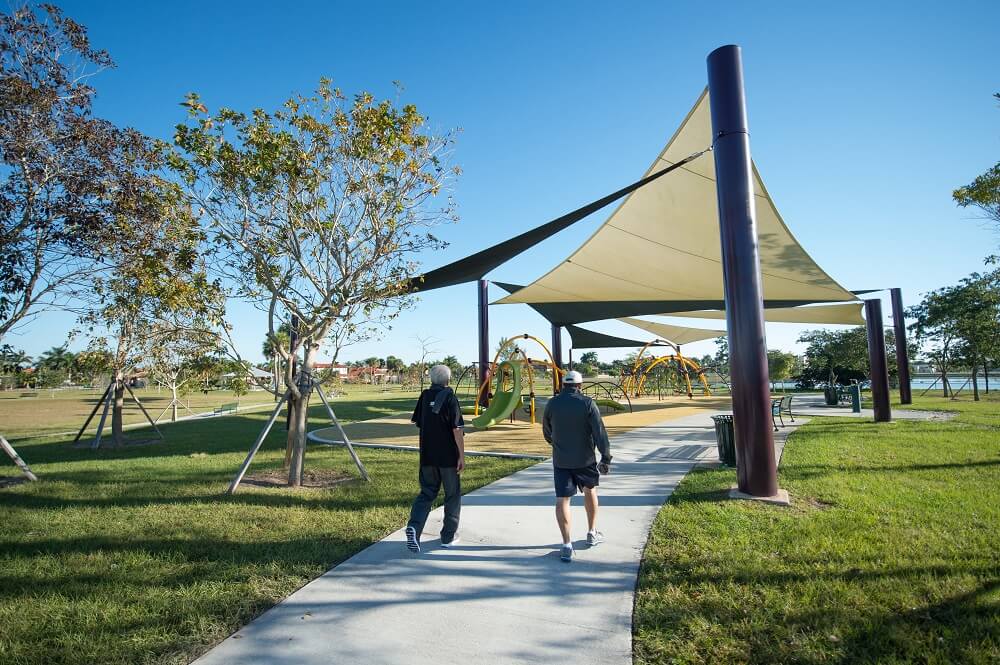7.4: Update regulations to protect the environment and promote resilient growth
Issue Statement and Context
Miami-Dade needs to build greener, cooler, and more pedestrian-friendly communities – supporting increased density, transit connectivity, public health, and blue-green jobs – and we need our code and planning guidelines to match these goals. Research shows the importance of green areas for mitigating extreme heat and also to alleviate flooding and improve water quality before it is introduced into the environment. Natural stormwater management systems (or "bioswales") are crucial year-round, not just during hurricanes.
However, a general drive toward higher-density, pedestrian-friendly development can sometimes come at the expense of planning for open space for trees and green areas. For example, our Complete Streets guide calls for wider sidewalks, which often leave less room for trees. And the fact is that in the urban core of Miami-Dade, we are running out of adequate spaces to plant trees. That makes long-term planning and policies to incorporate parks, green areas, and other nature-based infrastructure in our communities more important than ever.
One measure the County has been advancing is an ordinance to regulate the amount of impervious surface area that is allowed in new developments. The County can do more to promote thoughtful community planning and land use policies that balance the need for denser, more walkable neighborhoods – which can reduce car dependency and lower our emissions – with the need for space for parks and natural vegetation that make our communities, particularly those already experiencing extreme heat, that much more livable.
However, a general drive toward higher-density, pedestrian-friendly development can sometimes come at the expense of planning for open space for trees and green areas. For example, our Complete Streets guide calls for wider sidewalks, which often leave less room for trees. And the fact is that in the urban core of Miami-Dade, we are running out of adequate spaces to plant trees. That makes long-term planning and policies to incorporate parks, green areas, and other nature-based infrastructure in our communities more important than ever.
One measure the County has been advancing is an ordinance to regulate the amount of impervious surface area that is allowed in new developments. The County can do more to promote thoughtful community planning and land use policies that balance the need for denser, more walkable neighborhoods – which can reduce car dependency and lower our emissions – with the need for space for parks and natural vegetation that make our communities, particularly those already experiencing extreme heat, that much more livable.

Detailed Action Summary
Update County's land use codes and planning guidelines to promote urban greening and resilient growth measures.
- Establish minimum tree canopy requirements through an update to the Street Tree Master Plan and Aesthetic Master Plan; update Complete Streets Design Guidelines.
- Identify opportunities to revise planning guidelines to facilitate tree planting.
- Update the County Public Works Manual to incorporate usage of bioswales and to promote elimination of impervious surfaces as part of stormwater management guidance.
- Revise land use code and planning guidelines to facilitate more adequate spaces for planting, less density of concrete and the use of cooler pavements, building materials, and roofs. Explore a bonus allowance of gentle density increases in current single family/duplex zoning with a covenant for increasing green areas and/or affordable housing in redeveloped properties. Develop a recommended zoning overlay for each participating jurisdiction.
- Create incentives for compliance with zoning policies, improve enforcement of non-compliance, and clearly articulate those processes for developers. This can include incorporating energy code compliance reviews in initial construction documents. And, for major buildings, requiring an update as part of 40-year recertification.
- Streamline tree planting permitting process to increase resident participation in urban greening.
